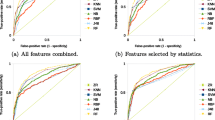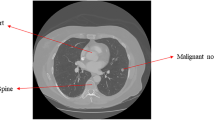Abstract
An intelligent clinical decision support system is proposed classifying lung nodules for lung cancer prediction using a kernel-induced random forest classifier. A contourlet filter is used for image denoising. Fuzzy logic is used to represent the segmented shape of a vessel tree. The fuzzy shape of the vessel tree is then given to a classifier as a feature for learning. A hybridization of expected maximization and total variation regularisation is proposed for the vessel tree segmentation. The proposed use of a fuzzy shape vessel tree and kernel-induced random forest classifier promises to be an efficient method of detecting lung nodules for cancer diagnosis. The proposed system is evaluated for precision, recall and accuracy in comparison with many previously available techniques.










Similar content being viewed by others
References
Wong MCS, Lao XQ, Ho K, Goggins WB, Tse SLA (2017) Incidence and mortality of Lung cancer: global trends and association with socioeconomic status. PMC Sci Rep 7:14300. https://doi.org/10.1038/s41598-017-14513-7
Messay T, Hardie RC, Rogers SK (2010) A new computationally efficient CAD system for pulmonary Nodule detection in CT imagery. Med Image Anal 14(3):390–406. https://doi.org/10.1016/j.media.2010.02.004
da Silva Sousa JRF, Silva AC, de Paiva AC, Nunes RA (2010) Methodology for automatic detection of Lung Nodules in computerized tomography images. Comput Methods Programs Biomed 98(1):1–14. https://doi.org/10.1016/j.cmpb.2009.07.006
Gomathi M, Thangaraj P (2010) A computer aided diagnosis system for detection of lung cancer nodules using extreme learning machine. Int J Eng Sci Technol 2(10):5770–5779
Diciotti S, Lombardo S, Falchini M, Picozzi G, Mascalchi M (2011) Automated Segmentation refinement of small Lung Nodules in CT scans by local shape analysis. IEEE Trans Biomed Eng 58(12):3418–3428. https://doi.org/10.1109/TBME.2011.2167621
Korfiatis PD, Kalogeropoulou C, Karahaliou AN, Kazantzi AD, Costaridou LI (2011) Vessel tree segmentation in presence of interstitial Lung disease in MDCT. IEEE Trans Inf Technol Biomed 15(2):214–220. https://doi.org/10.1109/TITB.2011.2112668
Netto SMB, Silva AC, Nunes RA, Gattass M (2012) Automatic Segmentation of Lung Nodules with growing neural gas and support vector machine. Comput Biol Med 42(11):1110–1121. https://doi.org/10.1016/j.compbiomed.2012.09.003
Sudha V, Jayashree P (2012) Lung Nodule detection in CT images using thresholding and morphological operations. Int J Emerg Sci Eng 1(2):17–21
Choi WJ, Choi TS (2012) Genetic programming-based feature transform and classification for the automatic detection of pulmonary Nodules on computed tomography images. Inf Sci 212:57–78. https://doi.org/10.1016/j.ins.2012.05.008
Flores-Fernández JM, Herrera-López E, Sánchez-Llamas F, Rojas-Calvillo A, Cabrera-Galeana PA, Leal-Pacheco G, Martínez-Velázquez M, GuadalupeGonzález-Palomar M, Femat R (2012) Development of an optimized multi-biomarker panel for the detection of lung cancer based on principal component analysis and artificial neural network modeling. Expert Syst Appl 39(12):10851–10856. https://doi.org/10.1016/j.eswa.2012.03.008
Keshani M, Azimifar Z, Tajeripour F, Boostani R (2013) Lung Nodule Segmentation and recognition using SVM classifier and active contour modeling: a complete intelligent system. Comput Biol Med 43(4):287–300. https://doi.org/10.1016/j.compbiomed.2012.12.004
Lingayat NS, Tarambale MR (2013) A computer based feature extraction of Lung Nodule in chest x-ray image. Int J Biosci Biochem Bioinf 3(6):624. https://doi.org/10.7763/IJBBB.2013.V3.289
Yuhua Gu, Kumar V, Hall LO, Goldgof DB, Li CY, Korn R, Bendtsen C, RiosVelazquez E, Dekker A, Aerts H, Lambin P, Li X, Tian J, Gatenby RA, Gillies RJ (2013) Automated delineation of Lung tumors from CT images using a single click ensemble Segmentation approach. Pattern Recognit 46(3):692–702. https://doi.org/10.1016/j.patcog.2012.10.005
Heidari S, Abdullah MT, Abdullah LN (2015) A novel four-directional thresholding approach for Lung computed-tomography images by using similarity-based Segmentation technique. J Comput Sci 11(1):195. https://doi.org/10.3844/jcssp.2015.195.203
Alilou M, Kovalev V, Snezhko E, Taimouri V (2014) A comprehensive framework for automatic detection of pulmonary Nodules in Lung CT images. Image Anal Stereol 33(1):13–27. https://doi.org/10.5566/ias.v33.p13-27
Likhitkar MVK, Gawande U, Hajari MKO (2014) Automated Detection of cancerous lung nodule from the computed tomography images. IOSR J Comput Eng 16(1):05–11
Hawkins SH, Korecki JN, Balagurunathan Y, Gu Y, Kumar V, Basu S, Gillies RJ, Hall LO, Goldgof DB, Gatenby RA (2014) Predicting outcomes of non-small cell Lung Cancer using CT image features. IEEE Access 2:1418–1426. https://doi.org/10.1109/ACCESS.2014.2373335
Choi WJ, Choi TS (2014) Automated pulmonary Nodule detection based on three-dimensional shape-based feature descriptor. Comput Methods Programs Biomed 113(1):37–54. https://doi.org/10.1016/j.cmpb.2013.08.015
Magdy E, Zayed N, Fakhr M (2015) Automatic classification of normal and Cancer Lung CT images using multiscale AM–FM features. J Biomed Imaging 2015:11. https://doi.org/10.1155/2015/230830
Nair Aswathy S, Jacob JE (2015) Automatic lung nodule detection on CT image using region growing. Int J Eng Adv Technol (IJEAT) 4(5):157–159
Dai S, Lu K, Dong J, Zhang Y, Chen Y (2015) A novel approach of lung segmentation on chest CT images using graph cuts. Neurocomputing 168:799–807. https://doi.org/10.1016/j.neucom.2015.05.044
Biradar Sunanda, Agalatakatti K (2015) Lung Cancer identification using CT images. Int J Eng Comput Sci 4(7):13022–13025
Moslemi A, Movafeghi A, Moradi S (2015) CT Medical images denoising based on new wavelet thresholding compared with curvelet and contourlet. World Acad Sci Eng Technol Int J Comput Electr Autom Control Inf Eng 9(10):2174–2179
Liu J, Ku YB, Leung S (2012) Expectation–maximization algorithm with total variation regularization for vector-valued image Segmentation. J Vis Commun Image Represent 23(8):1234–1244. https://doi.org/10.1016/j.jvcir.2012
https://wiki.cancerimagingarchive.net/display/Public/LIDC-IDRI
Author information
Authors and Affiliations
Corresponding author
Additional information
Publisher's Note
Springer Nature remains neutral with regard to jurisdictional claims in published maps and institutional affiliations.
Rights and permissions
About this article
Cite this article
Deepa, P., Suganthi, M. A fuzzy shape representation of a segmented vessel tree and kernel-induced random forest classifier for the efficient prediction of lung cancer. J Supercomput 76, 5801–5824 (2020). https://doi.org/10.1007/s11227-019-03002-5
Published:
Issue Date:
DOI: https://doi.org/10.1007/s11227-019-03002-5




